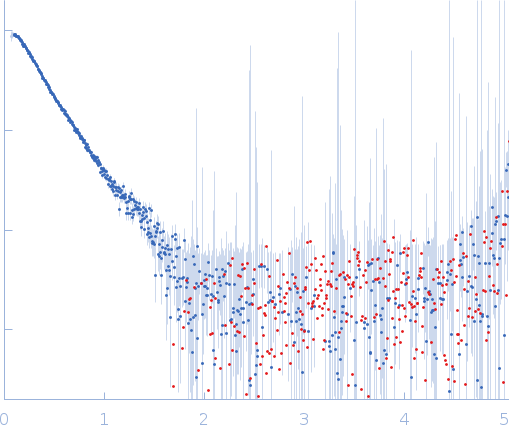|
Data sets were collected at the Stanford Synchrotron Radiation Lightsource (SSRL) Small Angle X-ray Scattering (SAXS) beamline, BL4–2. NifL samples were exchanged into the SEC-SAXS buffer containing 50 mM Bis-Tris, 100 mM ammonium sulfate, and 10% glycerol pH 7 for SAXS measurement. Samples were prepared at a concentration of approximately 85 µM (10 mg/mL) NifL, in the presence of 5 mM ADP or ATP, respectively. Reduced samples were prepared by two sequential exchanges into degassed SEC-SAXS buffer supplemented with 1 mM 1,1′-bis(3-sulfonatopropyl)-4,4′-bipyridinium (S2V). Samples injections of 20 µL, 35 µL, and 50 µL were run on a Superdex 200 PC 3.2/30 column at a flow rate of 0.05 mL/min. Scattering data was collected from the eluent stream with a 1-sec exposure every 5 seconds using a Dectris Pilatus 8 single photon counting device with a 2.5 m sample-to-detector distance and beam energy of 11 keV (wavelength, λ = 0.110 nm). Scattering profiles were generated, after buffer subtraction, using the beamline software SasTool (http://ssrl.slac.stanford.edu/~saxs/analysis/sastool.htm). SAXS analysis was performed using RAW 2.1.4 and the 2.8.0 ATSAS Package. The scattering curves corresponding to NifL and displaying a constant Rg from each injection volume of each sample were averaged, and GNOM from the ATSAS suite, was used to fit the data, calculate a P(r) curve, and estimate the Porod volume. Final experimental scattering curves for each sample were selected best on the best Guinier fit and GNOM quality estimates. Electron density maps for each sample were calculated by DENSS using the RAW plug-in, using the slow mode to average 100 reconstructions together.
|
|
 s, nm-1
s, nm-1